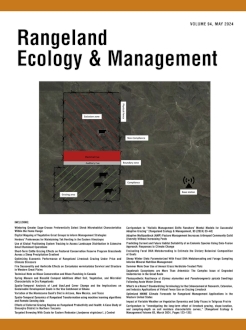Improved techniques are needed to estimate the dietary species composition of grazing animals. The fecal DNA metabarcoding technique has been proposed as a noninvasive method to determine dietary species composition. However, studies suggest that it is more effective to qualitatively estimate species composition of wild and domestic animals than for accurately quantifying diet composition. The technique, using the trnL barcode, was evaluated with 10 individually penned goats, which were fed hand-harvested plant materials that were collected fresh each morning before known amounts of each type of plant materials were fed and completely consumed by the goats. Goats were fed at 3% of their body weight on a DM basis. Broadleaf plant materials fed were Russian olive (Elaeagnus angustifolia), silver buffaloberry (Shepherdia argentea), western snowberry (Symphoricarpos occidentalis), and wormwood sage (Artemisia absinthium) plus a mixture of predominantly smooth bromegrass (Bromus inermis), which also included small amounts of other grasses such as Kentucky bluegrass (Poa pratensis) and forbs such as leafy spurge (Euphorbia esula). Estimates of the dietary composition of the goats were different (P ≤ 0.04) from those of their known dietary composition, except for wormwood sage when expressed on a crude protein basis (P = 0.98), regardless of whether known composition was expressed on a dry matter or crude protein basis. Therefore, we conclude that the fecal DNA metabarcoding technique for estimating the dietary composition of goat diets is useful qualitatively but needs further development to be a better quantitative technique.
BioOne.org will be down briefly for maintenance on 12 February 2025 between 18:00-21:00 Pacific Time US. We apologize for any inconvenience.
How to translate text using browser tools
17 May 2024
Evaluating Fecal DNA Metabarcoding to Estimate the Dietary Botanical Composition of Goats,
Robin Malik,
Scott L. Kronberg,
John R. Hendrickson,
Drew A Scott,
Edward S. DeKeyser,
Kevin K. Sedivec
ACCESS THE FULL ARTICLE

Rangeland Ecology and Management
Vol. 94 • No. 1
May 2024
Vol. 94 • No. 1
May 2024
browse
composition
diet
herbivores
technique




